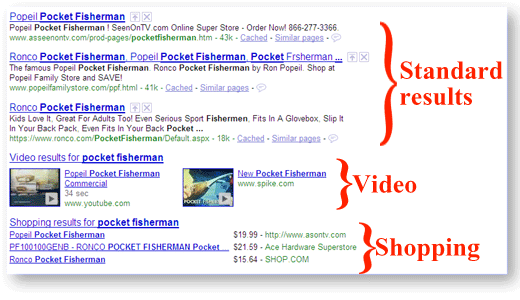Optimizing for Blended Search: Additional Search Categories for Organic Listings
 Have you heard of blended search? (That’s “search,” not “scotch.”) It’s when a search engine presents your search results from more than just webpages. It can include things like images, books, news and video.
Have you heard of blended search? (That’s “search,” not “scotch.”) It’s when a search engine presents your search results from more than just webpages. It can include things like images, books, news and video.
In 2007, Google released Universal Search, their flavor of blended search. On top of Google’s search engine results page, you’ll see categories of results that allow you to filter for things like images, news, shopping, etc. However, what comes up initially below the paid listings is the highest-ranked results from within in those categories. So, instead of just webpages, the organic listings (aka: non-paid) contain groupings of results within pertinent categories.
 |
Since organic search efforts have been focused on webpages, you can imagine how blended search is going to shake up the field of SEO. Instead of one category of search engine results, you now have multiple categories to contend with.
Consider video. Forrester Research reports that less than 20 percent of marketers insert keywords into the file names of their videos (e.g.: popeil-pocket-fisherman-tackle-portable-baitcaster-rod.mpg), and far fewer use the other metadata associated with video files. This optimization of video files is conceptually identical to optimization of webpages, and certainly applies to all the other search results returned in blended searches.
According to the Forrester Blog for Interactive Marketing Professionals:
Optimizing video content to take advantage of blended search is by far the easiest way to get a first-page organic ranking on Google.
[… ]
Not only are video results increasingly common in Google’s search results, but your videos stand a much better chance than your text pages of being shown on the first results page. On the keywords for which Google offers video results, we found an average of 16,000 videos vying to appear on results pages containing an average of 1.5 video results — giving each video about an 11,000-to-1 chance of making it onto the first page of results. By comparison, there were an average of 4.7 million text pages competing for a place on results pages with an average of just 9.4 text results — giving each text page about a 500,000-to-1 chance of appearing on the first page of results. Now that’s a lot of math, but here’s what it means: on the keywords for which Google offers video results, any given video in the index stands about a 50 times better chance of appearing on the first page of results than any given text page in the index. Those are some attractive odds.
One important advantage at this point in time is that most videos aren’t very well optimized. This means any optimization on your part could lead to a significant jump in ranking for your efforts. Forrester’s Nate Elliot has the following suggestions on how to optimize video for blended search. Keep in mind that some of these ideas could apply to different document types that show up in blended search categories such as images.
• Insert keywords into your video filenames.
• Host your videos on YouTube, and embed those YouTube videos into your own site. Google says its algorithms consider how many times a video is viewed, and any views embedded videos receive on your own site get added to the “views” tally on YouTube. (And yes, nearly every video we saw Google blend into its results came from YouTube.)
• Optimize your YouTube videos by writing keywords into your videos’ titles, descriptions, and tags.
• Embed videos into relevant text pages on your site. The context provided by the text on those pages (which is hopefully already optimized for search as well) will help the search engines figure out what your videos are about.
• Create a video library on your site, so Google knows where to find your video content. (Google Video Sitemaps can help with this too.) Write keyword-rich annotations for each video in the library.

 The future of digital experiences will be built by strategists who grasp the full array of emerging business, social, and technical models. Specialties in user experience, branding, application design, and data science are laying the foundation for richer user experiences and business models breakthrough products and revenue based marketing.
The future of digital experiences will be built by strategists who grasp the full array of emerging business, social, and technical models. Specialties in user experience, branding, application design, and data science are laying the foundation for richer user experiences and business models breakthrough products and revenue based marketing.
Comments are closed.